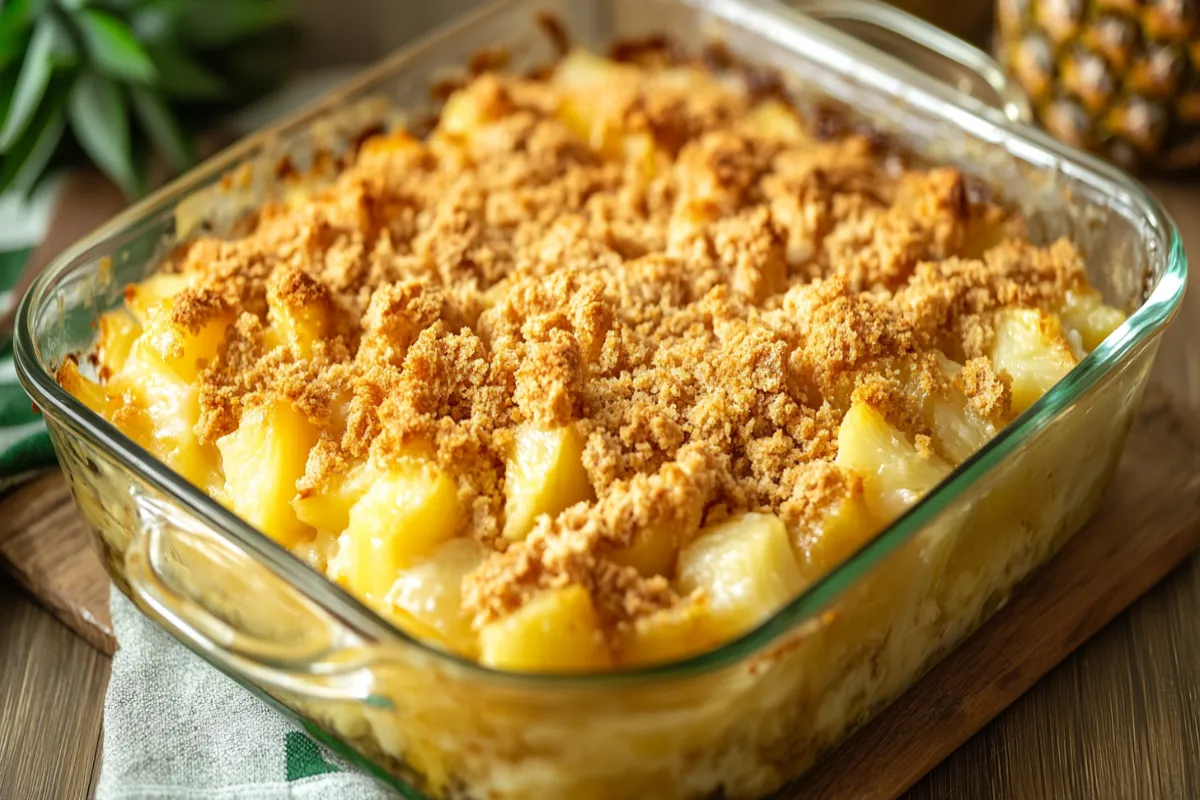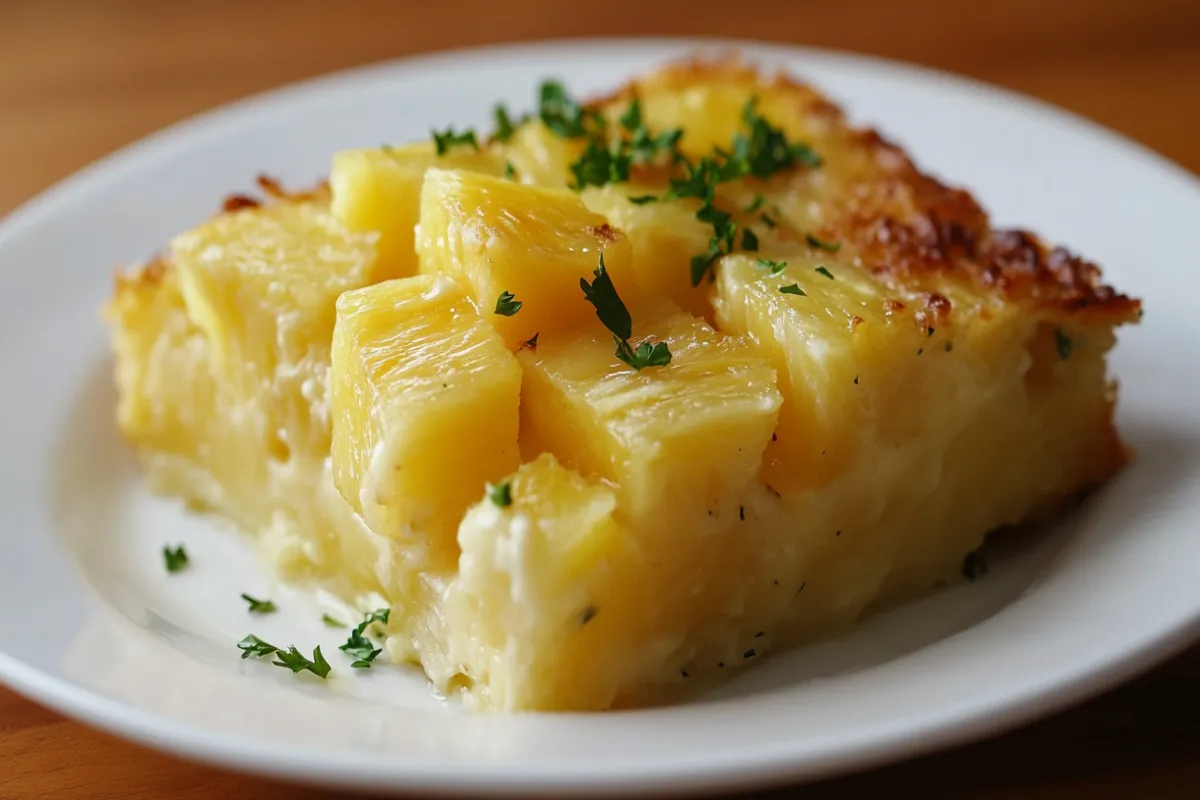Table of Contents
- Introduction: What is Pineapple Casserole?
- The Origins of Pineapple Casserole
- Key Ingredients for Pineapple Casserole
- Pineapple
- Cheese
- Topping
- How to Make Pineapple Casserole at Home
- Step 1: Prepare the Ingredients
- Step 2: Mix the Pineapple Base
- Step 3: Add the Topping
- Step 4: Bake to Perfection
- Tips for the Best Pineapple Casserole
- Variations of Pineapple Casserole
- Pineapple Casserole with Nuts
- Tropical Pineapple Casserole
- Health Benefits of Pineapple
- Frequently Asked Questions (FAQs)
- Conclusion: A Comforting Sweet and Savory Dish
Introduction: What is Pineapple Casserole?
Pineapple casserole is a delightful Southern dish that combines sweet, juicy pineapple with tangy cheese and a buttery, crunchy topping. Although it might sound unusual to pair pineapple with cheese and a crumbly cracker topping, this casserole has become a beloved classic in many Southern households. Its unique blend of flavors makes it a versatile dish, perfect for holiday feasts, family gatherings, or even as a side dish to complement savory main courses.
The key to pineapple casserole lies in its balance of contrasting textures and flavors. The sweet and tart pineapple, combined with the creamy, tangy cheese, creates a luscious filling. This filling is then topped with a mixture of buttery crackers, such as Ritz, that adds a satisfying crunch to each bite. Baked until golden and bubbly, the casserole has a comforting warmth that’s both sweet and savory.
In this article, we will explore the origins of pineapple casserole, its key ingredients, and a step-by-step guide to making it at home. We will also look at some variations of the recipe and provide tips for achieving the perfect balance of flavors in this classic dish.
The Origins of Pineapple Casserole
Pineapple casserole originated in the Southern United States, where creative cooks often combine unexpected ingredients to create dishes that balance sweet and savory flavors. The exact origins of this dish are somewhat unclear, but it is known to have roots in Southern home cooking. Pineapple was historically seen as a luxury item, symbolizing hospitality and warmth, which may have contributed to its use in special family meals and holiday gatherings.
Traditionally, pineapple casserole is served as a side dish, often paired with ham, roast chicken, or turkey. Its contrasting flavors make it an ideal complement to savory meats, while its sweetness offers a refreshing break from heavier dishes. Over the years, pineapple casserole has become a staple in Southern cooking, cherished for its comforting and nostalgic qualities.
Today, this dish can be found at potlucks, family reunions, and holiday dinners across the South. Its unique combination of flavors and simple preparation continue to make it a popular choice for cooks looking to add a touch of Southern comfort to their meals.
Key Ingredients for Pineapple Casserole
The beauty of pineapple casserole lies in its simplicity. Made with just a handful of ingredients, this dish comes together quickly and effortlessly. Here are the key components:
Pineapple
The star of this casserole is, of course, the pineapple. Canned pineapple chunks or tidbits work best for this recipe because they are easy to use and provide a consistent level of sweetness. Opt for pineapple packed in juice rather than syrup to avoid an overly sweet casserole. The natural tartness of pineapple helps balance the richness of the other ingredients.
Cheese
Cheddar cheese is the traditional choice for pineapple casserole. The sharpness of cheddar contrasts beautifully with the sweetness of the pineapple, creating a flavor combination that is both surprising and delicious. For the best texture, use shredded cheese and mix it evenly into the pineapple base.
Topping
The topping typically consists of crushed buttery crackers like Ritz, combined with melted butter and a bit of sugar. This creates a crunchy, golden layer on top of the casserole. The salty, buttery flavor of the crackers complements the sweet pineapple and tangy cheese, adding another dimension to the dish. Some variations may also include a sprinkle of cinnamon or nutmeg for extra warmth and depth.
How to Make Pineapple Casserole at Home
1: Prepare the Ingredients
Ingredients:
- 2 cans (20 ounces each) of pineapple chunks in juice, drained
- 1 cup granulated sugar
- 6 tablespoons all-purpose flour
- 2 cups shredded cheddar cheese
- 1 cup crushed buttery crackers (such as Ritz)
- 1/2 cup melted butter
Instructions:
- Preheat your oven to 350°F (175°C).
- Drain the canned pineapple chunks thoroughly and set them aside.
2: Mix the Pineapple Base
- In a large mixing bowl, combine the drained pineapple chunks, sugar, and flour. The sugar adds sweetness, while the flour helps thicken the mixture as it bakes, creating a luscious sauce.
- Add the shredded cheddar cheese to the bowl and stir until everything is well combined. The cheese will melt during baking, forming a creamy, flavorful base that pairs perfectly with the pineapple.
3: Add the Topping
- In a separate bowl, mix the crushed crackers with the melted butter until the crumbs are evenly coated. This creates a crunchy topping that will turn golden and crisp in the oven.
- Sprinkle the cracker mixture evenly over the pineapple and cheese mixture, covering the entire surface.
4: Bake to Perfection
- Place the casserole dish in the preheated oven and bake for 25-30 minutes, or until the topping is golden brown and the filling is bubbling around the edges.
- Remove from the oven and let it cool for a few minutes before serving. The casserole can be enjoyed warm, allowing the flavors to meld together beautifully.
Tips for the Best Pineapple Casserole
- Choose the Right Pineapple: Opt for canned pineapple in juice rather than syrup. The natural tartness of pineapple juice helps balance the dish’s overall sweetness.
- Use Freshly Shredded Cheese: Grating the cheese yourself provides a smoother melting texture compared to pre-shredded cheese, which often contains anti-caking agents.
- Control the Sweetness: Adjust the amount of sugar to your preference. If you prefer a less sweet casserole, reduce the sugar by half.
- Add Spices for Extra Flavor: For a twist, sprinkle a bit of cinnamon or nutmeg into the topping mixture. This adds warmth and complexity to the dish.
- Serve Warm: Pineapple casserole tastes best when served warm. The melted cheese and crispy topping create a delightful contrast of textures.

Variations of Pineapple Casserole
Pineapple Casserole with Nuts
For added texture and a bit of crunch, consider incorporating chopped nuts such as pecans or walnuts into the casserole. The nuts provide a delightful contrast to the sweet and creamy pineapple base. Simply mix a handful of chopped nuts into the topping mixture before sprinkling it over the casserole. This variation adds a nutty richness that complements the dish’s sweetness.
Tropical Pineapple Casserole
For a tropical twist, add other fruits like mango or shredded coconut to the casserole. Mix mango chunks with the pineapple base, and sprinkle shredded coconut into the topping mixture. This version gives the dish a more exotic flavor profile, perfect for summer gatherings or potlucks.
The Health Benefits of Pineapple
Pineapple is not only delicious but also packed with nutrients. It is an excellent source of vitamin C, which supports the immune system and helps the body absorb iron. Pineapple also contains bromelain, an enzyme that aids in digestion and has anti-inflammatory properties.
In addition, pineapple provides dietary fiber, promoting healthy digestion and helping to prevent constipation. The natural sugars in pineapple give it its sweet flavor, but these sugars are accompanied by fiber, which helps slow down their absorption and prevent spikes in blood sugar levels.
While pineapple casserole is a comforting dish, it is important to enjoy it in moderation due to its sugar and butter content. By choosing pineapple packed in juice and controlling the amount of added sugar, you can create a version that fits into a balanced diet.
Frequently Asked Questions (FAQs)
Can I use fresh pineapple for this casserole?
Yes, you can use fresh pineapple, but you will need to cut it into small chunks and ensure it’s properly drained to avoid excess moisture in the casserole. Fresh pineapple tends to be more tart, so you may want to adjust the sugar content to suit your taste.
How do I store leftover pineapple casserole?
Store leftover pineapple casserole in an airtight container in the refrigerator. It will keep for up to 3 days. To reheat, place it in an oven-safe dish and warm it in a preheated oven at 350°F (175°C) until heated through.
Can I make pineapple casserole ahead of time?
Yes, you can assemble the casserole a day in advance, cover it, and refrigerate it until you are ready to bake. Just add the topping right before baking to ensure it remains crunchy.
Conclusion: A Comforting Sweet and Savory Dish
Pineapple casserole is a beloved Southern dish that perfectly balances sweet and savory flavors. With its combination of juicy pineapple, tangy cheese, and buttery cracker topping, it brings comfort and nostalgia to any meal. Easy to make with simple ingredients, this casserole is a versatile dish, fitting for both holiday feasts and everyday dinners.
By following the recipe and tips outlined in this article, you can create the perfect pineapple casserole at home. Feel free to experiment with variations like adding nuts or tropical fruits to customize the dish to your liking. Whether served as a side or enjoyed on its own, pineapple casserole is sure to become a favorite on your table.


